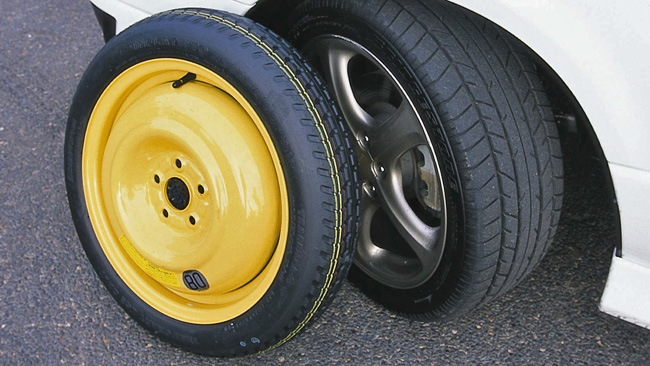
Most of the car owners agree that a spare tire is a useful safety net, but this is not necessarily meant to replace the flat tire if their car indefinitely.
Not all types of spare tire are made equal, so keep in mind to check your car owner’s manual guide to have a better understanding of which substitute model that you should have. In general, a temporary spare tire often does not have nearly the lifespan of a usual tire. This is because it is designed with only a layer of polyester in its sidewall and 2 belts of steel, along with a layer of polyester in its tread, meaning that it cannot withstand nearly as much road abuse as a usual tire.
Space-savers/donuts
These small spare tires are often known as donuts or space-savers since they are very light and do not take up a lot of space in the cargo area of your car. In addition, it is also much easier for an average person to lift them and install. These are the main reasons why they have increasingly become a popular choice amongst car owners these days.

However, because they are designed with a more compact and smaller form, they do not possess two important aspects of a standard tire, including stability and durability. Most of those spare tires available on the market often have a limited max speed of about 55 miles per hour, while a few models are rated up to 70 miles per hour. Therefore, you can expect to drive at approximately 50 miles with a spare tire. That might be enough for you to look for a tire store in which you can find a good tire, or a professional mechanic who could patch up the flat.
Full-size Spare Tires
A couple of auto manufacturers also offer full-size spare tires. Even though those models take up more space and are much heavier, they are durable and robust, meaning that they will be able to last for a longer time than the space-saver, or donut kinds of tire.

Nevertheless, full-size spare tires are often designed with a different type of rubber compound or tread compared to usual types of car tire, which can have a negative affect overall safety as well as handling while you are driving on the road. As these types of spare tire are very durable, they are made to help a car driver get to the final destination before he has to deal with a flat tire.
Should You Have a Spare Tire?
If you do not want to prepare a spare tire, then your vehicle might be equipped with run-flat tires, which are probably one of the toughest tire types available on the market and can withstand any punctures and keep on going. But keep in mind that these are not made to go on forever. MINI and BMW tend to provide their cars with these types of tire right from the production line.
A lot of run-flat tire manufacturers highly recommend that you need to replace them shortly after seeing a puncture. In general, these tires are often only able to run up to 50 miles after being punctured before requiring a replacement.
Some tire stores could patch up a run-flat tire, but original equipment manufacturers do not always recommend this path mainly because replacing a run-flat tire is really expensive compared to a usual one. Other car manufacturers have recourse to only offering a flat tire repair kit in the vehicle in order to save costs and weight. You can find the Instructions for this task in an owners’ manual guide.
Conclusion
To sum up, the most important thing to keep in mind is that if you have a flat tire in your car, you need to have it replaced. A spare tire is only the temporary replacement, and while a full-size spare might have the similar size as a regular tire, it might not be the same type of tire, which could lead to a couple of issues.
Remember that the tires of your car are the only things that connect you and your home to the road, so do not take risks on the safety while driving.
Leave a Reply